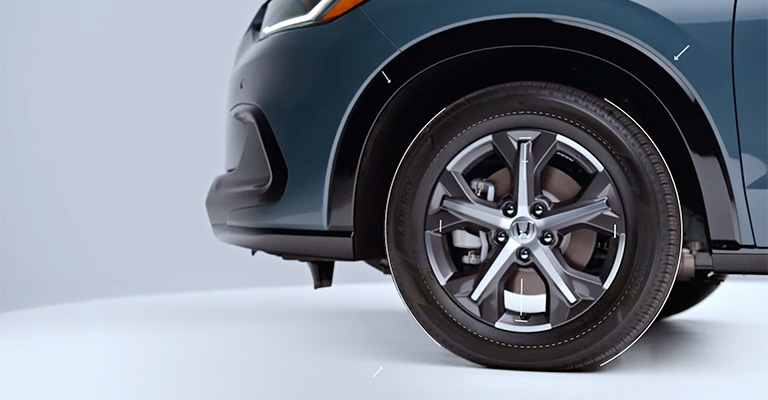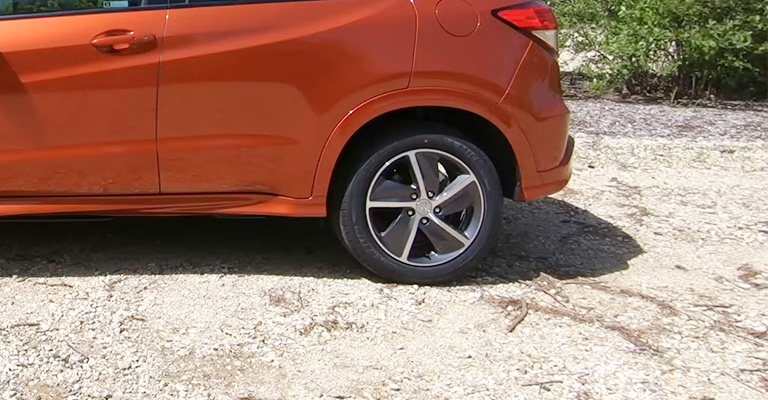The Honda HR-V is a popular subcompact crossover SUV that has recently gained much attention. One important aspect of owning a vehicle is understanding its bolt pattern. The bolt pattern refers to the number of bolts on a vehicle’s wheel hub and the distance between them.
In the case of the Honda HR-V, the bolt pattern is a crucial piece of information that any owner or potential owner should know. It determines which wheels can be installed on the vehicle, affecting its overall performance and aesthetics.
Therefore, understanding the Honda HR-V bolt pattern is essential for anyone who wants to customize their vehicle’s wheels or needs to replace a damaged one.
This article will explore the Honda HR-V bolt pattern, its specifications, and its significance for owners and enthusiasts.

List of Honda HR-V Models and Their Respective Bolt Patterns
Here is a list of Honda HR-V models and their respective bolt patterns
- Honda HR-V 1.6L (1999-2005): 5×114.3 bolt pattern
- Honda HR-V 1.6 i (1998): 5×114.3 bolt pattern
- Honda HR-V 1.6i (1998-2007): 5×114.3 bolt pattern
- Honda HR-V 1.5L (2015-2021): 5×114.3
- Honda HR-V 1.8L (2016-2021): 5×114.3
- Honda HR-V Sport 1.5L (2019-2021): 5×114.3
- Honda HR-V EX 1.8L (2022): 5×114.3
- Honda HR-V Sport 1.5L (2022): 5×114.3
- Honda HR-V Touring 1.5L (2022): 5×114.3
- Honda HR-V (2022-2024): 5×114.3 Bolt pattern
It’s worth noting that these bolt patterns apply to the original equipment wheels and may not necessarily apply to aftermarket wheels with different bolt patterns.

Here is a table that shows the Honda HR-V model name, displacement, and corresponding bolt pattern
| Model Name & Displacement | Bolt Pattern |
|---|---|
| Honda HR-V 1.5L (2015-2021) | 5×114.3 |
| Honda HR-V 1.8L (2016-2021) | 5×114.3 |
| Honda HR-V Sport 1.5L (2019-2021) | 5×114.3 |
| Honda HR-V EX 1.8L (2022) | 5×114.3 |
| Honda HR-V Sport 1.5L (2022) | 5×114.3 |
| Honda HR-V Touring 1.5L (2022) | 5×114.3 |
| Honda HR-V (2022-2024) | 5×114.3 |
Other Fitment Specs You Should Know
In addition to bolt pattern, there are a few other important fitment specifications to consider when choosing wheels for your Honda HR-V
Center Bore
The center bore is the size of the hole in the center of the wheel that fits over the hub of the car. Choosing wheels with a center bore that matches the hub size on your Honda HR-V; otherwise, the wheels may not fit securely. The center bore size for the Honda HR-V is 64.1mm.
Offset
The offset of a wheel is the distance between the wheel’s mounting surface and the rim’s centerline. It determines how far the wheel will sit from the hub and how much clearance there will be between the wheel and the fender.
The offset for the Honda HR-V ranges from +35mm to +50mm, depending on the specific model.
Tire Size
When selecting new wheels for your Honda HR-V, choosing a tire size that is compatible with the new wheel size is important.
The tire size will also impact the overall diameter of the wheel and tire assembly, which can affect the accuracy of the speedometer and other vehicle systems. The recommended tire size for the Honda HR-V is 215/60R17.
Load Rating
The load rating of a wheel is the maximum weight that it can safely support. It’s important to choose wheels with a load rating appropriate for the weight of your Honda HR-V and any cargo it may carry. The load rating for the Honda HR-V is typically around 1,500 lbs per wheel.
Honda HR-V Other Fitment Specs Per Generation
Here’s a table for the other fitment specs per generation of the Honda HR-V
| Generation | Production Years | Wheel Size | Wheel Offset | Center Bore | Lug Nut Thread Size | Lug Nut Torque |
|---|---|---|---|---|---|---|
| 1st | 1999 – 2006 | 15 – 16 inches | +45 – +55 mm | 64.1 mm | 12mm x 1.5 | 80 lb-ft |
| 2nd | 2015 – 2021 | 17 – 18 inches | +45 mm | 64.1 mm | 12mm x 1.5 | 80 lb-ft |
| 3rd | 2022 – present | 17 – 18 inches | +45 mm | 64.1 mm | 12mm x 1.5 | 80 lb-ft |
Note: The above table provides general fitment specs for each generation of Honda HR-V. However, these specs may vary by trim level and year, so it’s important to consult the owner’s manual or a reliable source for the exact fitment information for your specific vehicle.
Why Knowing Blot Pattern is Important?
Knowing your vehicle’s bolt pattern is important because it determines which wheels will fit on your car. The bolt pattern is the circle’s diameter made by the wheel lugs’ centers.
It is usually expressed in millimeters and is denoted as a series of numbers, such as “4×100”, where “4” is the number of lugs on the wheel and “100” is the diameter of the circle formed by the lug centers.
If you purchase wheels with the wrong bolt pattern, they will not fit in your car, which can cause many problems. For example, the wheels may not bolt onto the hub or sit flush with the brake rotor or drum.
Using wheels that are not the correct size and bolt pattern can cause vibration, instability, and even damage to your vehicle’s suspension or steering systems.
Knowing your car’s bolt pattern is essential for ensuring that you purchase wheels that are compatible with your vehicle, which will help you maintain optimal performance, handling, and safety on the road.
How do you measure the Honda HR-V Bolt Pattern?
Here are the steps to measure the bolt pattern of a Honda HR-V
Gather the Necessary Tools
You will need a tape measure, a straight edge or ruler, and a bolt pattern gauge. A bolt pattern gauge is a tool specifically designed to measure the bolt pattern of a wheel and can be purchased at an auto parts store.
Remove the Wheel
To accurately measure the bolt pattern, you must remove the wheel from the vehicle. Refer to your vehicle’s owner’s manual for instructions on safely removing a wheel.
Clean the Hub Face
Use a wire brush or other appropriate cleaning tool to remove any dirt, debris, or rust from the hub face of the wheel hub.
Measure the Bolt Circle
Place the bolt pattern gauge over the studs on the hub face. The gauge will have multiple pins that will fit into the holes in the wheel. Take note of the distance between the centers of two opposite holes. This distance will give you the diameter of the bolt circle.
Determine the Number of Studs
Count the number of studs on the hub. Most Honda HR-Vs have 5 studs, but verifying this before purchasing new wheels is important.
Verify Fitment
Check the wheel specifications against the vehicle’s owner’s manual or speak with a reputable tire or wheel specialist to ensure that the new wheels are compatible with the Honda HR-V’s specific model, trim level, and year.
It’s important to note that some Honda HR-V models may have different bolt patterns or stud counts, depending on the specific year and trim level.
Always verify the correct bolt pattern for your vehicle before purchasing new wheels to ensure proper fitment and safe driving.
How to Tighten Honda HR-V Bolts?
Here is a detailed guide on how to tighten bolts on a Honda HR-V
Determine the Type of Bolt
Before you begin tightening bolts, you must know what type of bolt you’re dealing with. Honda HR-V models typically use either lug bolts for the wheels or head bolts for the engine.
Gather Necessary Tools
To tighten bolts, you’ll need a torque wrench, which is a tool that measures the amount of force you’re applying to the bolt. You should also have a socket wrench and sockets of the appropriate size for the bolt you’re tightening.
Check the Manufacturer’s Specifications
Knowing the manufacturer’s recommended torque specifications for each bolt you’re tightening is important. These specifications can be found in the Honda HR-V owner’s manual or in a service manual.
Loosen the Bolt
Before you can tighten a bolt, you may need to loosen it first. Use your socket wrench to loosen the bolt, turning it counterclockwise. Only loosen the bolt enough to be able to tighten it back to the proper torque.
Set the Torque Wrench
Adjust the torque wrench to the manufacturer’s recommended torque specification for the bolt you’re tightening.
Tighten the Bolt
Use your socket wrench to tighten the bolt to the specified torque, turning it clockwise. Be careful not to over-tighten the bolt, as this can cause damage to the Honda HR-V or even break the bolt.
Double-check Your Work
After you’ve tightened the bolt to the recommended torque, use your torque wrench to check that the torque is still within the specified range. If it’s not, loosen the bolt and repeat the process.
Note that there may be exceptions depending on the Honda HR-V model, trim level, and year. For example, some models may require the use of a different type of torque wrench or different torque specifications.
Always refer to the Honda HR-V owner’s manual or service manual for specific instructions and guidelines.
Final Words
Knowing the bolt pattern and other fitment specifications of your Honda HR-V is crucial when it comes to choosing and installing new wheels or tires. The bolt pattern is the most important fitment specification as it determines which wheels will fit your vehicle.
Other fitment specifications, such as center bore, offset, and thread size, are also important to ensure proper fitment and safe driving.
When it comes to tightening bolts, it is important to use a torque wrench and follow the manufacturer’s recommended torque settings to prevent over-tightening or under-tightening, which can lead to wheel or brake issues.
By understanding these specifications and following proper installation techniques, you can ensure the safety and longevity of your Honda HR-V’s wheels and tires.
Check Other Honda Models Bolt Pattern –

Leave a Reply